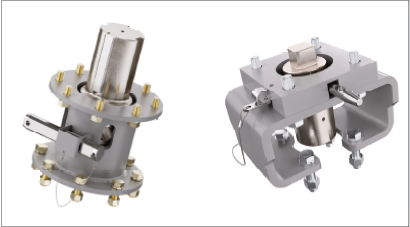A chain is only as strong as its weakest link. It is therefore worth asking: What is the weakest link in your automated valve assembly? Is it the mounting kit? When inadequately designed mounting kits are integrated into a precisely calibrated system, the safety and efficiency of the entire system are at risk. It is therefore important to consider the impact of mounting kits and how they affect valve safety.
By Tony Lambert, Vice President Engineered Valve Automation Hardware – VanAire
Oh, the humble mounting kit. It connects the valve to the actuator and serves the entire system year after year, cycle after cycle, asking for no credit and demanding zero attention.
For years, many people considered the bracket to be ‘just a piece of bent metal,’ but recent global standards acknowledge that the bracket is, indeed, a critical part of the valve automation ecosystem. When installed, or used incorrectly, the integrity of the systems they are to be used in face substantial risks. These can include inaccurate process measurements due to hysteresis, premature valve failure, mounting kit component failures (bracket, coupling, fasteners), and failed locking mechanisms. The byproducts of these failures range from excessive downtime to, personal injury or worse.
Risk of Failure
It is important to understand the different ways a valve assembly failure can occur in the field.
In some cases, the assembly does not function at peak performance and may fail to actuate. In other cases, excessive deflection in the bracket can lead to unwanted stresses on the valve stem and packing, which can result in failures.
These failures are not only dangerous, but they can also be exorbitantly expensive to diagnose and repair. Imagine an oil platform out at sea that needs to shut down for an extended period while they wait for new parts to be manufactured and airlifted in.
The key to a safe and reliable mounting kit is in-depth knowledge of the imperative mounting kit features and the industry standards that influence them.
Imperative Features
Stiffness
Material Properties can vary from one material to another, while different cross sections can deflect at different rates. Add in factors, such as temperature and load, and the variables can quickly cause problems. Specifying a material that maintains its stiffness across all these scenarios is very important. Just because a material looks okay in the shop doesn’t mean it will perform in the field.
Standards Related to Stiffness
API 6DX – 2020
“Deflections of the mounting kit shall not prevent the valve closure member from reaching the fully closed or fully open position or restrict actuator functionality.”
ISO/DIS 5115.2
“The intermediate support design shall be sufficiently strong by design and material selection to ensure no visibly discernible movement of the actuator from twisting or warping of the intermediate support during operation.”

Parallelism
Parallelism is the relation of the different planes of an object to each other. In a mounting bracket, if the planes are not perfectly aligned and maintained under load, internal stresses occur that can cause premature failure of the valve and actuator assembly.
Standards Related to Parallelism
ISO 12490 – 2011
“The mounting kit design and manufacturing tolerance shall ensure the following: Parallelism of the intermediate support mounting faces.”
API 6DX – 2020
“The mounting kit design shall ensure the following: Parallelism of the mounting spool mounting faces.”
Concentricity
Concentricity is a three-dimensional cylindrical tolerance zone. All median points along the entire feature must be in this tolerance zone. Similar to parallelism, if a mounting kit is not concentric the entire system is prone to fail due to the different parts of the system not fitting together in the required specification.
Standards Related to Concentricity
ISO 12490 – 2011
“The mounting kit design and manufacturing tolerance shall ensure the following: Concentricity of the PCD of the bolting of the intermediate support and alignment of the PCD, valve stem, coupling and the actuator drive.”
API 6DX – 2020
“The mounting kit design shall ensure the following: Concentricity of the bolting of the mounting spool, and alignment of the valve stem, coupling, and actuator drive.”
Welding
When bonding materials together using welded joints, both the right welder for the job and the right engineer are required to determine where in the system a weld should occur. Welds in locations that are highly stressed, or welds done by unqualified professionals can lead to excess flex and eventually system failure.
Standards Related to Welding
9.2 Structural Welding
“Welding, including repair welding, of structural welds, including mounting kit, shall be performed in accordance with procedures qualified to AWS D1.1/D1.1M or an equivalent standard. Welders and welding operators shall be qualified in accordance with AWS D1.1/D1.1M or an equivalent standard.”
Surface Protection
Whether mounting kit components are powder-coated, painted, electroless nickel-coated, or made from a corrosion-resistant material, surface protection is a key factor. Without it, corrosion can contribute to a shortened lifespan of an automated valve assembly.

Standards Related to Surface Protection
API 6DX – 2020 12 Surface Protection
“Actuators, mounting spools (including internal surfaces), couplings, and fasteners in contact with the environment shall be protected against corrosion in accordance with the manufacturer’s standards or purchase requirements.”
Application Environment
The environment in which the valve assembly exists is a frequently over- looked scenario. Imagine the difference in stressors on a one-ton assembly mounted vertically inside an enclosed space on land versus that same assembly mounted horizontally at sea. Horizontal mounts have exponentially more factors to consider and, of course, the salt air wreaks havoc on all systems.
One should not be afraid to ask for de-tailed documentation on the installation environment. In the long run, the customer will appreciate it.
The Key Application Environment Factors to Consider
- Temperature (process and ambient)
- Number of cycles
- Cycle speed
- Material selection
- Fasteners
- Bracket height
- Actuator orientation

Summary
It is important when working with a mounting kit partner to take the time to ask detailed questions about the imperative mounting kit features and the industry standards that influence them. When the correct questions are asked, and require an accurate answer, the installed systems can have a lifespan that sets a company, and team, apart from the competition.
Imperative features of a mounting kit include, but are not limited to:
- Stiffness
- Parallelism
- Concentricity
- Welding
- Surface protection
- Application environment



